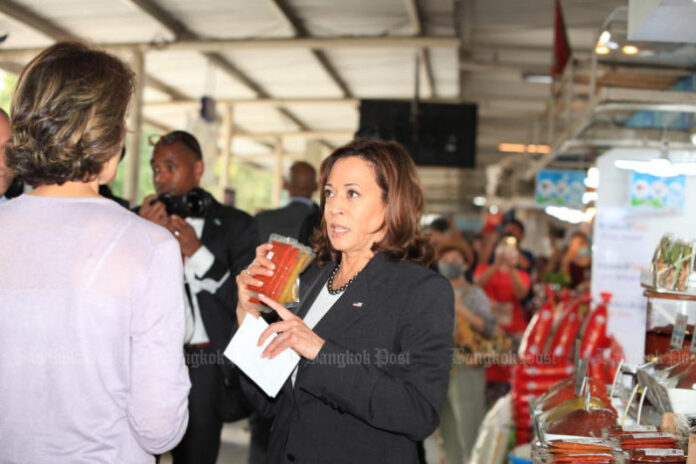US Vice President Kamala Harris turned up at the Or Tor Kor market and bought several kinds of curry paste and a bunch of lemon grass to take back to the US on Nov 20, 2022. (Photo: Apichart Jinakul)
The popularity of Thai cultural resources got another boost courtesy of visits to major tourist attractions in Bangkok by French President Emmanuel Macron and US Vice President Kamala Harris during the Apec summit.
The French leader visited several tourist sites in the capital, such as Wat Phra Chetuphon (Wat Pho), Ratchadamnoen Boxing Stadium and Yaowarat, or Chinatown.
Ms Harris, meanwhile, turned up at the Or Tor Kor market and bought several kinds of curry paste and a bunch of lemon grass to take back to the US.
She also paid a courtesy call on the Supreme Patriarch at historic Wat Ratchabophit and was given a tour of the temple.
Singapore Prime Minister Lee Hsien Loong uploaded photos on his social media account of the “Welcome to Thailand” dish served to world leaders at Apec’s gala dinner, and the cultural performances for guests at the dinner.
The country’s rich culinary tradition and culture were also showcased at the Apec Economic Leaders’ Week (AELW) for delegates and media to sample and enjoy.
These cultural highlights were shared across the globe on both mainstream and social media.
With the government aiming to increase the kingdom’s economic value by promoting Thailand’s food, film, fashion, fighting (Thai martial arts) and festivals (known as the five “Fs”), businesses see this as an opportunity for the government to cash in and drive global demand.
If it pursues the opportunity, the government will do the tourism industry a service, they say.
Still reeling from the impact of the Covid-19 pandemic, the sector could use a global buzz to attract international arrivals and spur tourism activities.
Honeymoon time
Chamnan Srisawat, president of the Tourism Council of Thailand, said Apec 2022 was phenomenal in boosting the country’s appeal and building tourist confidence — something that must be earned.
The number of tourist arrivals during the rest of this year is likely to push total numbers for 2022 to the 10-11 million mark targeted following the success of the Apec summit.
The number of foreign visitors this year so far is 8-9 million.
“The council has talked about this number since the year began. While the Tourism Authority of Thailand predicted the number of visitors would be 4-5 million, we said it could reach 12-16 million.
“Our estimates were from the supply side, from hotel and airline bookings,” he said.
He thanked the government and Thais for making the event a success despite some street protests.
Tourism authorities made the right decision to focus on short-haul markets to offset the absence of Chinese tourists, he said.
“China is really a key factor but the world faces the same situation. If China had just shunned us, that would be an issue,” he said.
Speaking based on his experience at the World Trade Mark (WTM) in the UK, Thailand’s strength lies with tourism, he said.
With the pandemic easing and the buzz generated by the Apec meeting, nothing will stop the sector from recovering next year. As soon as China reopens, tourism activities will be back in full swing.
Mr Chamnan said while many are concerned about inflation, which reduces tourists’ spending power, the country needs only 3-5% of global travellers to come.
However, he urged the government to “redesign” tourism products, invest in improving tourist sites and roll out tourism promotional campaigns to support small and medium-sized operators to help them get back on their feet.
“I’m confident next year will be the honeymoon period for Thai tourism. But the government has to redesign its products and take care of the supply side that was battered by the pandemic.
“The ‘Thai Tiew Thai’ scheme should also continue, treating it as a booster shot. A campaign like this can help operators with small funds to carry on.
“They should redesign health and wellness tourism and the Mice market to draw in another 10 million visitors,” he said.
BCG model and tourism
At Apec 2022, the government pushed the bio-, circular and green (BCG) economic development model to serve as a roadmap for Apec sustainability and inclusive development.
The bio-economy involves the production of renewable biological resources and the conversion of these resources into value-added products; the circular economy is about an upcycling process to add value to unwanted materials; and the green economy deals with keeping growth and the environment in balance.
Chaiyapruek Thongkham, chairman of the domestic tourism association, said sustainability has been the core of community tourism and businesses are adopting the BCG model.
Major provinces such as Khon Kaen, Nakhon Ratchasima, Nakhon Phanom and Udon Thani are equipped to cater to sustainable and green travellers, but smaller provinces have limited carrying capacity.
He said this group of visitors are both Free Individual Travellers (FIT), who usually travel solo or in small groups in contrast to group tours, and corporates, who seek to support the local economy while trying to lessen the environmental impacts of their travel.
These travellers pay attention to low carbon policies, services and products designed to mitigate climate change and many foreign tour agencies make inquiries about carbon credits and offsets, he said.
Domestic tourists can also support emerging “BCG” tourist destinations, he said. They can learn about these sites at the website of the Designated Areas for Sustainable Tourism Administration (Dasta).
He said tourism received a huge boost from the Apec summit especially after the French president’s visits to many cultural highlights like Yaowarat, a street food haven, and a Muay Thai boxing fight.
“His visits boosted the country’s tourism image. Thailand is among the very first countries that fully opened to visitors. The arrivals are likely to exceed the target,” he said.
As for the domestic tourism market, Chiang Mai, Chiang Rai and Nan, all popular destinations among Thais during the cool season, have reported solid bookings of between 80%-90% capacity, while Phuket and Krabi have registered bookings of 80% and 70%, respectively.
Overall, hotel bookings are about 60%-70% occupancy.
A key factor is the price of air tickets, which have been driven up by fuel costs. That means more foreign visitors must be high-spending tourists.
The market is reporting a surge in long-stay tourists from Saudi Arabia and Russia, with the former expected to spend several hundreds of thousands of baht per person.
Yaowarat’s new look
Yaowarat, or Chinatown, is included in City Hall’s plan to promote the distinct characteristics and local specialities of each neighbourhood to boost tourism.
Wanlop Kiatworasrikul, chief of Samphanthawong district office, said the district has much to offer to visitors in addition to a range of enticing street food.
Like the 1.8-kilometre Yaowarat Road, Wat Traimit Wittayaram (Golden Buddha Temple) and Talad Noi are flooded with visitors and the district will work with the local council to see what can be done to promote economic activities next year.
In the meantime, the district office will give Yaowarat a facelift by improving the physical environment to accommodate street vendors and pedestrians.
Food carts will be put in order, and their appearance harmonised.
“If possible, we’ll change the pavement in Yaowarat and the lighting. We also plan to get food carts in order and require them to put in a grease trap to treat wastewater before it is discharged into the sewers,” he said.
A tourism promotion plan between Samphanthawong and Phra Nakhon districts is afoot to link Yaowarat and Phadung Krung Kasem canal to Khao San Road.
Puchatr Guna-tilaka, a 54-year-old businessman based in the Thong Lor area, said street food vendors and restaurants across the capital use celebrity power to promote their businesses.
“You’ll see photos of celebrities hanging on their walls. It is an old-fashioned way of product endorsement. When we see these photos, we feel like we’ve come to the right place and the food tastes even better.
“The government could do more by encouraging foreign visitors to travel here. Tourism authorities and Thai embassies around the world need to tell them what we have to offer,” he said.
Good days are coming
The Or Tor Kor market, opposite the Chatuchak weekend market, is a fresh market where locals come to get stocks of farm and grocery products.
Panitan Meechaiyo, director of the Or Tor Kor market, said he and vendors were delighted to have welcomed Ms Harris and proud she went here to shop for food.
Ms Harris’s visit raised not only the market’s profile but also put ingredients for Thai cuisine in the spotlight. The Or Tor Kor market will use this opportunity to improve demand.
With the city expanding and supermarkets popping up across the city, many shoppers make fewer visits.
However, following Ms Harris’ visit, some vendors say they have started receiving calls from old customers.
Narueseth Udomkul, a 58-year-old curry paste vendor, said the market is bustling after her visit, and more orders are coming in.
He said she was a lively person and clearly had a fantastic time touring the market. Judging by her excitement, it seems she had never seen some of the ingredients before.
Saingern Jingdee, a 44-year-old vendor, said she was surprised to see Ms Harris and even more so when she stopped by her stall to buy makham piak or moist tamarind pulp.
She too reports more calls from potential buyers. She is also thinking about improving her products and packaging to boost sales.










